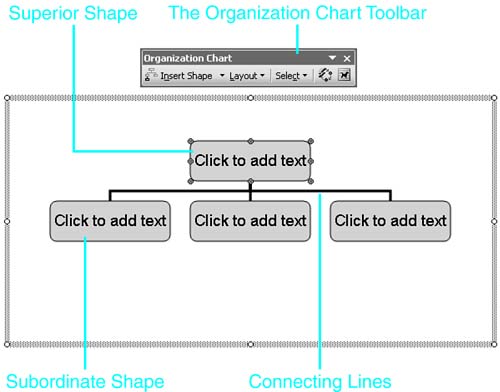About Word's Organization Chart Feature
One of the most dreaded assignments any white-collar worker can get is to draw up a new organization chart?a diagram that shows the relationships between people working in an organization. Trying to keep all the boxes and lines straight with Word's regular drawing tools can be challenging at best. Fortunately, Word 2003 contains a powerful, easy-to-use tool specifically designed for building organization charts.
TIP
Beyond organization charts, you can use Word's organization chart tool to create any diagram that requires a hierarchical structure. For example, you might use it to present the high-level organization of a Web site.
NOTE
Word 2003 also provides several other types of business diagrams, including cycle, radial, pyramid, Venn, and target diagrams. These are covered later in this chapter.
You can access Word's organization chart tool by choosing Insert, Picture, Organization Chart. You can also click the Diagram Gallery button on the Drawing toolbar (use View, Toolbars, Drawing to enable this toolbar), and then double-click the Organization Chart icon.
Whichever method you choose, Word displays a default organization chart with one top-level employee and three subordinates (see Figure 15.26). Word also displays the Organization Chart toolbar, which contains all of Word's tools for organizing and editing organization charts. This toolbar's buttons are described in Table 15.3.
Figure 15.26. Working with Word's default organization chart.

Button | Function |
|---|---|
| Inserts boxes for subordinates, assistants, and co-workers |
| Selects layouts and controls the size of your organization chart and drawing canvas |
| Selects portions of an organization chart, including levels, branches, assistants, and connecting lines |
| Displays options for reformatting organization charts |
| Displays options for wrapping text around or through organization charts |
After you've inserted an organization chart, here are some of the tasks you can perform:
Enter and format text in text boxes representing each individual
Insert new shapes representing subordinates, co-workers, and assistants
Format individual shapes using tools similar to those available for formatting text boxes
Adjust the layout of your overall organization chart; you can, for example, utilize hanging layouts that represent lists of employees vertically
Select elements of your organization chart, such as levels or branches, and perform limited formatting on them
Reformat the entire organization chart using one of 15 built-in diagram styles
Specify certain formatting that applies to the organization chart as a whole; for example, a background or text wrapping settings
CAUTION
When you are working with organization charts and other diagrams from the Diagram Gallery, Word's Undo feature is somewhat limited. Although you can undo text entries, you cannot undo adding or deleting a box for an employee.
NOTE
You can delete a box by right-clicking on it and choosing Delete from the shortcut menu.
Entering and Formatting Text in an Organization Chart Box
After you've inserted an organization chart, you'll want to begin entering text corresponding to the names of each individual. To enter text inside a shape in your organization chart, click on it and begin typing.
TIP
You can move among boxes in an organization chart by using the arrow keys?up, down, left, and right.
Each shape contains a text box, and these text boxes work much as they do elsewhere in Word. For example, you can select text and format it using the controls on the Standard toolbar (such as the alignment and font formatting buttons).
You can also change the size, color, borders, or inside margins of a text box by right-clicking on it and choosing Format AutoShape from the shortcut menu.

If Word won't let you adjust the colors or lines of a text box in an organization chart, see "What to Do If Word Won't Let You Control AutoShape Formatting in Organization Charts or Diagrams," in the "Troubleshooting" section of this chapter. |
Inserting New Shapes in an Organization Chart
It's unlikely that your organization consists of exactly one superior and three subordinates. To add a box for another employee, follow these steps:
Click on the box representing the individual your new employee will report to, or work with.
On the Organization Chart toolbar, click the down arrow next to Insert Shape.
Choose the relationship your new employee has to the employee you selected: Subordinate, Coworker, or Assistant.
If you choose Subordinate, Word inserts a new box below the employee you have selected, with a vertical connecting line between them.
If you choose Coworker, Word inserts the new employee to the right of the employee you selected, on the same level of the organization chart.
If you choose Assistant, Word inserts the new employee below, and to the left or right, of the existing employee. The new assistant is connected to the existing employee with a right-angle "elbow" connecting line.
If necessary, when Word inserts a new employee, it adjusts the rest of your organization chart layout to make room.
Moving a Shape in an Organization Chart
As companies reorganize, responsibilities and reporting arrangements change constantly. You'll often be called on to move boxes in an organization chart. To do so, select the box you want to move, and drag it over the box containing the individual's new supervisor. Word places the box under the new supervisor and adds a reporting line between them.
If you want to move an individual and all the individuals who report to him or her, click Select, Branch on the Organization Chart toolbar; then drag the individual over the box containing his or her new supervisor. All of the individual's subordinates will follow as well.

Deleting a Shape from an Organization Chart
Occasionally, you'll need to remove an employee from an organization chart. To do so, right-click on the employee's box and choose Delete from the shortcut menu. If you delete an individual with subordinates, all the subordinates are deleted as well.







